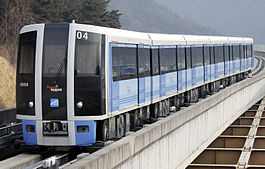This article needs additional citations for verification. (December 2015) |
Busan Metro Line 4 (4호선) is a rubber-tyred metro line of the Busan Metro network that connects part of Gijang-gun, Busan, and upper Haeundae-gu, Busan, into Dongnae-gu, Busan Korea. It is operated by the Busan Transportation Corporation. Opened on 30 March 2011,[1] the line is a rapid transit (metro) system consisting of 14 stations - 8 underground, 1 on-ground, and 5 above-ground.[2] The line color is blue. A trip through the entire line takes about 24 minutes. Unlike lines 1 to 3 of Busan Metro, the trains are driverless and run with pneumatic tires on concrete track (Roll way) between two guide bars. Line 4 was originally planned to be simply a branch of Line 3 (similar to Seoul Subway Line 2's Sinjeong and Seongsu branches), but was turned into its own line later.
| Line 4 | |||||||||||||||||||||||||||||||||||||||||||||||||||||||||||||||||||||||||||||||||||||||||||||||||||||||||||||||||||||||||||||||||||||||||||||||||||||||||||||||||||||||||||||||||||||||||||
|---|---|---|---|---|---|---|---|---|---|---|---|---|---|---|---|---|---|---|---|---|---|---|---|---|---|---|---|---|---|---|---|---|---|---|---|---|---|---|---|---|---|---|---|---|---|---|---|---|---|---|---|---|---|---|---|---|---|---|---|---|---|---|---|---|---|---|---|---|---|---|---|---|---|---|---|---|---|---|---|---|---|---|---|---|---|---|---|---|---|---|---|---|---|---|---|---|---|---|---|---|---|---|---|---|---|---|---|---|---|---|---|---|---|---|---|---|---|---|---|---|---|---|---|---|---|---|---|---|---|---|---|---|---|---|---|---|---|---|---|---|---|---|---|---|---|---|---|---|---|---|---|---|---|---|---|---|---|---|---|---|---|---|---|---|---|---|---|---|---|---|---|---|---|---|---|---|---|---|---|---|---|---|---|---|---|---|---|
 | |||||||||||||||||||||||||||||||||||||||||||||||||||||||||||||||||||||||||||||||||||||||||||||||||||||||||||||||||||||||||||||||||||||||||||||||||||||||||||||||||||||||||||||||||||||||||||
| Overview | |||||||||||||||||||||||||||||||||||||||||||||||||||||||||||||||||||||||||||||||||||||||||||||||||||||||||||||||||||||||||||||||||||||||||||||||||||||||||||||||||||||||||||||||||||||||||||
| Native name | 4호선(4號線) Sa Hoseon | ||||||||||||||||||||||||||||||||||||||||||||||||||||||||||||||||||||||||||||||||||||||||||||||||||||||||||||||||||||||||||||||||||||||||||||||||||||||||||||||||||||||||||||||||||||||||||
| Status | Operational | ||||||||||||||||||||||||||||||||||||||||||||||||||||||||||||||||||||||||||||||||||||||||||||||||||||||||||||||||||||||||||||||||||||||||||||||||||||||||||||||||||||||||||||||||||||||||||
| Termini | |||||||||||||||||||||||||||||||||||||||||||||||||||||||||||||||||||||||||||||||||||||||||||||||||||||||||||||||||||||||||||||||||||||||||||||||||||||||||||||||||||||||||||||||||||||||||||
| Stations | 14 | ||||||||||||||||||||||||||||||||||||||||||||||||||||||||||||||||||||||||||||||||||||||||||||||||||||||||||||||||||||||||||||||||||||||||||||||||||||||||||||||||||||||||||||||||||||||||||
| Service | |||||||||||||||||||||||||||||||||||||||||||||||||||||||||||||||||||||||||||||||||||||||||||||||||||||||||||||||||||||||||||||||||||||||||||||||||||||||||||||||||||||||||||||||||||||||||||
| Type | Rapid transit | ||||||||||||||||||||||||||||||||||||||||||||||||||||||||||||||||||||||||||||||||||||||||||||||||||||||||||||||||||||||||||||||||||||||||||||||||||||||||||||||||||||||||||||||||||||||||||
| System | Busan Metro | ||||||||||||||||||||||||||||||||||||||||||||||||||||||||||||||||||||||||||||||||||||||||||||||||||||||||||||||||||||||||||||||||||||||||||||||||||||||||||||||||||||||||||||||||||||||||||
| Services | 1 | ||||||||||||||||||||||||||||||||||||||||||||||||||||||||||||||||||||||||||||||||||||||||||||||||||||||||||||||||||||||||||||||||||||||||||||||||||||||||||||||||||||||||||||||||||||||||||
| Operator(s) | Busan Transportation Corporation | ||||||||||||||||||||||||||||||||||||||||||||||||||||||||||||||||||||||||||||||||||||||||||||||||||||||||||||||||||||||||||||||||||||||||||||||||||||||||||||||||||||||||||||||||||||||||||
| Depot(s) | Anpyeong | ||||||||||||||||||||||||||||||||||||||||||||||||||||||||||||||||||||||||||||||||||||||||||||||||||||||||||||||||||||||||||||||||||||||||||||||||||||||||||||||||||||||||||||||||||||||||||
| Rolling stock | Woojin Industrial EMU Class 4000 | ||||||||||||||||||||||||||||||||||||||||||||||||||||||||||||||||||||||||||||||||||||||||||||||||||||||||||||||||||||||||||||||||||||||||||||||||||||||||||||||||||||||||||||||||||||||||||
| History | |||||||||||||||||||||||||||||||||||||||||||||||||||||||||||||||||||||||||||||||||||||||||||||||||||||||||||||||||||||||||||||||||||||||||||||||||||||||||||||||||||||||||||||||||||||||||||
| Opened | 30 March 2011 | ||||||||||||||||||||||||||||||||||||||||||||||||||||||||||||||||||||||||||||||||||||||||||||||||||||||||||||||||||||||||||||||||||||||||||||||||||||||||||||||||||||||||||||||||||||||||||
| Technical | |||||||||||||||||||||||||||||||||||||||||||||||||||||||||||||||||||||||||||||||||||||||||||||||||||||||||||||||||||||||||||||||||||||||||||||||||||||||||||||||||||||||||||||||||||||||||||
| Line length | 10.8 km (6.7 mi) | ||||||||||||||||||||||||||||||||||||||||||||||||||||||||||||||||||||||||||||||||||||||||||||||||||||||||||||||||||||||||||||||||||||||||||||||||||||||||||||||||||||||||||||||||||||||||||
| Number of tracks | 2 | ||||||||||||||||||||||||||||||||||||||||||||||||||||||||||||||||||||||||||||||||||||||||||||||||||||||||||||||||||||||||||||||||||||||||||||||||||||||||||||||||||||||||||||||||||||||||||
| Track gauge | 1,700 mm (5 ft 6+15⁄16 in) | ||||||||||||||||||||||||||||||||||||||||||||||||||||||||||||||||||||||||||||||||||||||||||||||||||||||||||||||||||||||||||||||||||||||||||||||||||||||||||||||||||||||||||||||||||||||||||
| Electrification | 750 V DC guide bars | ||||||||||||||||||||||||||||||||||||||||||||||||||||||||||||||||||||||||||||||||||||||||||||||||||||||||||||||||||||||||||||||||||||||||||||||||||||||||||||||||||||||||||||||||||||||||||
| |||||||||||||||||||||||||||||||||||||||||||||||||||||||||||||||||||||||||||||||||||||||||||||||||||||||||||||||||||||||||||||||||||||||||||||||||||||||||||||||||||||||||||||||||||||||||||
Line 4's station signs have blue frames, sharing their design with the station sign design used in some stations of Line 1, such as Seomyeon and Dongnae. Their main body is white and circled by a blue frame and the station name is printed in big Hangul near the top with smaller English and Hanja names near the bottom, with the English name having the station number beside it. The arm that points to the next station has that station's name in it and a pointed end, while the arm that has the previous station's name printed on it and points to that station has a concave indent.
Lines 3 and 4
editWhile Busan Metro Line 3 was being planned, the planners thought about making what is now Busan Metro Line 4 the 2nd phase of Busan Metro Line 3. However, for several reasons, they have made this 2nd phase into a new line called Busan Subway Line 4.
Archaeology
editCompared to Line 3, Line 4 took quite a long time for its construction. There are many reasons for this; however the most significant one is that there were many artifacts found in the construction site of the line, including those from the time of the Three Kingdoms of Korea and the Joseon Dynasty. These artifacts had great historical value,[3] so they caused the completion date of the line to be delayed from its original date of opening in 2008. Some of these artifacts are being displayed inside a historical museum dedicated to this in Suan Station (the museum opened on 28 January 2011).
Rolling stock
editWoojin Industrial System Company Limited, supplied urban rubber tire trains for Line 4.[4]
List of stations
editAll stations are in Busan.
| Station Number |
Station name | Transfer | Distance in km |
Total distance |
Location | ||||
|---|---|---|---|---|---|---|---|---|---|
| English | Hangul | Hanja | |||||||
401
|
Minam | 미남 | 美南 | ---
|
0.0
|
||||
402
|
Dongnae | 동래 | 東萊 | 1.0
|
1.0
| ||||
403
|
Suan | 수안 (동래읍성임진왜란역사관) |
壽安 (東來邑城壬辰倭亂歷史館) |
0.7
|
1.7
| ||||
404
|
Nangmin | 낙민 | 樂民 | 0.6
|
2.3
| ||||
405
|
Chungnyeolsa | 충렬사 (안락) |
忠烈祠 (安樂) |
0.6
|
2.9
| ||||
406
|
Myeongjang | 명장 | 鳴藏 | 0.6
|
3.5
| ||||
407
|
Seo-dong | 서동 | 書洞 | 0.9
|
4.4
|
||||
408
|
Geumsa | 금사 | 錦絲 | 0.6
|
5.0
| ||||
409
|
Banyeo Agricultural Market | 반여농산물시장 | 盤如農産物市場 | 0.7
|
5.7
|
||||
410
|
Seokdae | 석대 | 石坮 | 1.1
|
6.8
| ||||
411
|
Youngsan University | 영산대 (아랫반송) |
靈山大 (아랫盤松) |
1.2
|
8.0
| ||||
412
|
Witbansong | 윗반송 | 윗盤松 | 1.3
|
9.3
| ||||
413
|
Gochon | 고촌 | 古村 | 0.6
|
9.9
|
||||
414
|
Anpyeong | 안평 (고촌주택단지) |
安平 (古村住宅團地) |
0.9
|
10.8
| ||||
See also
editReferences
edit- ^ "'국내 첫 무인경전철' 부산도시철도 4호선 개통". Naver (in Korean). 30 March 2011.
- ^ "사업개요". 부산교통공사. Archived from the original on 11 January 2010. Retrieved 14 March 2010.
- ^ "반송선<도시철도 3호선 2단계>, 문화재에 발목잡히나". 엄창현, 오상준. Archived from the original on 22 December 2015. Retrieved 28 March 2010.
- ^ "(untitled)". Woojin Industrial System Co., Ltd. Archived from the original on 11 January 2016. Retrieved 19 October 2015.
External links
edit- Introduction of Busan Metro Line 4 (Korean text)